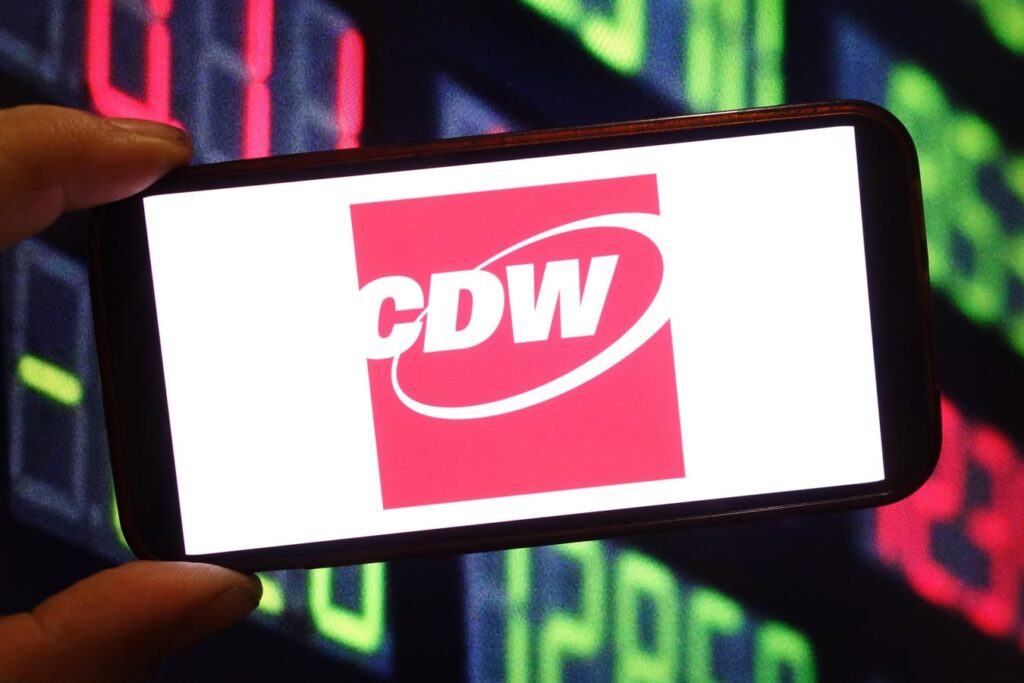CDW (NASDAQ:CDW), a reseller of technology products and services, experienced a rise in its stock of approximately 7% on Wednesday after announcing Q1 2025 results that exceeded expectations, including an adjusted earnings increase of nearly 10% to $286.5 million. This quarter’s growth was fueled by escalating demand for notebooks, desktops, mobile devices, software, and services.
Multiple industry trends are propelling the company’s growth. For instance, businesses are increasing their investment in hybrid work solutions and cloud-based software, resulting in higher demand for mobile devices and software-as-a-service tools. Concurrently, public sector IT modernization, especially in the healthcare and education sectors, is gaining momentum. As IT requirements become more complex, firms are choosing partners capable of delivering comprehensive solutions, an advantage for CDW, which has extensive offerings and a robust vendor network.
How Does CDW’s Valuation Compare to The S&P 500?
When considering what you pay per dollar of sales or profit, CDW stock appears affordable relative to the broader market.
• CDW has a price-to-sales (P/S) ratio of 1.0 compared to 2.8 for the S&P 500
• Additionally, the company’s price-to-free cash flow (P/FCF) ratio stands at 16.7 versus 17.6 for the S&P 500
• Furthermore, it features a price-to-earnings (P/E) ratio of 19.8, while the benchmark’s ratio is 24.5
How Have CDW’s Revenues Evolved in Recent Years?
CDW’s Revenues have experienced slight growth over the past few years.
• CDW’s revenue has increased at an average rate of 0.8% over the last 3 years (compared to an increase of 6.2% for the S&P 500)
• Its revenues have declined by 1.8% from $21 Bil to $21 Bil in the previous 12 months (whereas the S&P 500 experienced a growth of 5.3%)
How Profitable Is CDW?
The profit margins of CDW are considerably lower than most companies in the Trefis coverage universe.
• CDW’s Operating Income over the past four quarters was $1.7 Bil, which translates to a weak Operating Margin of 7.9% (compared to 13.1% for the S&P 500)
• CDW’s Operating Cash Flow (OCF) during this timeframe was $1.3 Bil, indicating a poor OCF Margin of 6.1% (versus 15.7% for S&P 500)
• Over the last four quarters, CDW’s Net Income stood at $1.1 Bil, reflecting a poor Net Income Margin of 5.1% (compared to 11.3% for S&P 500)
Is CDW Financially Stable?
The balance sheet of CDW appears fragile.
• At the end of the most recent quarter, CDW had a Debt figure of $6.0 Bil, while its market capitalization is $23 Bil (as of 5/7/2025). This results in a moderate Debt-to-Equity Ratio of 28.1% (compared to 21.5% for S&P 500). [Note: A lower Debt-to-Equity Ratio is preferable]
• Cash (including cash equivalents) constitutes $718 Mil of the total assets of $15 Bil for CDW. This results in a poor Cash-to-Assets Ratio of 4.9% (compared to 15.0% for S&P 500)
How Resilient is CDW Stock During a Downturn?
CDW stock has experienced an impact that was slightly greater than the benchmark S&P 500 index during several recent downturns. While investors hope for a gentle landing for the U.S. economy, how severe could it get if there is another recession? Our dashboard How Low Can Stocks Go During A Market Crash illustrates the performance of key stocks during and after the last six market crashes.
Inflation Shock (2022)
• CDW stock dropped 26.7% from a peak of $208.13 on January 4, 2022, to $152.59 on October 12, 2022, compared to a peak-to-trough decline of 25.4% for the S&P 500
• The stock completely recovered to its pre-crisis peak by February 13, 2023
• Following this recovery, the stock increased to a high of $257.87 on March 27, 2024, and presently trades at approximately $175
Covid Pandemic (2020)
• CDW stock fell 45.0% from a high of $144.60 on January 15, 2020, to $79.56 on March 20, 2020, in contrast to a peak-to-trough decline of 33.9% for the S&P 500
• The stock fully recovered to its pre-Crisis peak by February 4, 2021
Putting All The Information Together: Implications for CDW Stock
In conclusion, CDW’s performance across the metrics mentioned above is as follows:
• Growth: Neutral
• Profitability: Very Weak
• Financial Stability: Weak
• Downturn Resilience: Neutral
• Overall: Weak
Thus, even with its moderate valuation, this renders the stock risky and reinforces our view that CDW may not presently be a wise investment choice.
While CDW stock appears discouraging, investing in a single stock carries inherent risks. Conversely, the Trefis High Quality (HQ) Portfolio, comprising a selection of 30 stocks, has a history of consistently outperforming the S&P 500 over the previous 4 years. What accounts for this? As a collective, HQ Portfolio stocks have yielded better returns with lower risk in comparison to the benchmark index; they present a smoother investment experience as evidenced in HQ Portfolio performance metrics.
Read the full article here


